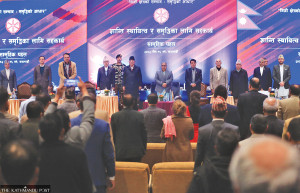Entertainment
Are frogs next to go extinct?
Back when I was eleven-years-old, during the rainy season, I remember hastily sprinting to obey my mom’s cry, “Bring the dogs in, or else they’ll eat the frogs.”
Sampanna Bhattarai
Back when I was eleven-years-old, during the rainy season, I remember hastily sprinting to obey my mom’s cry, “Bring the dogs in, or else they’ll eat the frogs.” It was honestly the last thing any child could wish for in Kathmandu’s gloomy downpour, but nevertheless I did it, cursing, with each step, the frog’s intentions to belong in an unwanted space. They were everywhere—from our doorsteps to the far-away meadows to even shallow ponds, and I absolutely hated them.
Fast forward eight more years, and they’re all gone; something I couldn’t have imagined a few years ago was even declining in its population is now being dragged towards extinction. The same child—now twenty years-old—feels sorry for those frogs: only if I had the knowledge back then of how they played a crucial role in our ecosystem, maintaining an important link in the food chain between insects and other top predators, I wouldn’t have ever held a firm dislike against them.
When I first heard about what scientists are terming as the “Sixth Mass Extinction”, I could easily relate to those frogs seemingly disappearing from our backyard for no reason: where did they all go? It happens that the overabundance of pesticides in our lands couldn’t be tolerated by those amphibians. Some people, as absurd as it may sound, apparently sold frogs for only two rupees per piece. Not only frogs, even the sparrows chirping across the skies in Kathmandu, another species that wasn’t even predictable would wither away so soon, have all suddenly disappeared into the plummeting forests due to the ever-increasing human population of the Kathmandu valley.
Experts believe that humans are responsible for most of the recent mass extinctions, and that we shall be the drivers for what’s coming next: The Sixth Extinction. English scholar Thomas Malthus in 1798 predicted that with every arithmetic increase in the planet’s ability to feed everyone, there will be a geometric increase in human population. Of course, this also implies that humans will spread, even to the few of what’s left as forests, posing a major threat to the biodiversity there. More mankind equates even more competition for resources, which means animals in the wild should have a hard time living tranquilly in their natural habitats. Plus, the looming threat from global warming, climate change and urbanisation—retaining all that’s living has become a major challenge.
With this hazardous increase in our population size, let us also draw our attention to the rapid decrease in the population of select species—frogs, for instance. Do we have a direct threat from their existence? Not at all. They are carnivores, but they do not pose any direct threat for humans. Not only are they natural creatures, but they are also part of our culture: if there is a drought, the Newars in Bhaktapur host a marriage ceremony for frogs, wishing for rainfall. A frog’s croaking sound also signifies rainfall in several communities. Sanskrit, our traditional language, encompasses sayings about frogs, such as Kupa Manduka, which translates as “a frog in a well”, signifying a slender vision of life. How could we explain sayings like these to future generations if we didn’t have any frogs remaining to draw analogies with?
Frogs are also used for scientific research and education all around the globe, and a decrease in their population, in many ways, means a big full stop for a lot of scientific advancements. They are also good test subjects: the African clawed frog, for example, shares 1700 DNA sequences with humans. High school biology is incomplete without frogs, as they have helped us understand evolution in classrooms for decades. Insects shall also increase with the absence of frogs because they’d have less predators; I’d rather choose a frog over a dozen insects, simply because of the overwhelming number of advantages a frog embodies over any insect.
True, we have other, more serious issues that demand our attention. The hygiene and sanitation of our dusty capital, Kathmandu, pose a threat to our lifestyle. But as individuals, some of our seemingly negligible habits might do good for an entire population of frogs, or any other endangered group of animals. On a governmental level, pesticides should be banned, but their current usage is greater than ever. If we encounter people, especially children, foraging streets with stones and catapults, let’s convince them not to kill animals. Frogs have lasted for about 250 million years now! They also belong to this planet just like us, and all other flora and fauna; let’s stand up for their rights, and not make our age notorious for massive extinctions in the coming years.
Bhattarai is a sophomore at New York University, Abu Dhabi




 6.31°C Kathmandu
6.31°C Kathmandu










